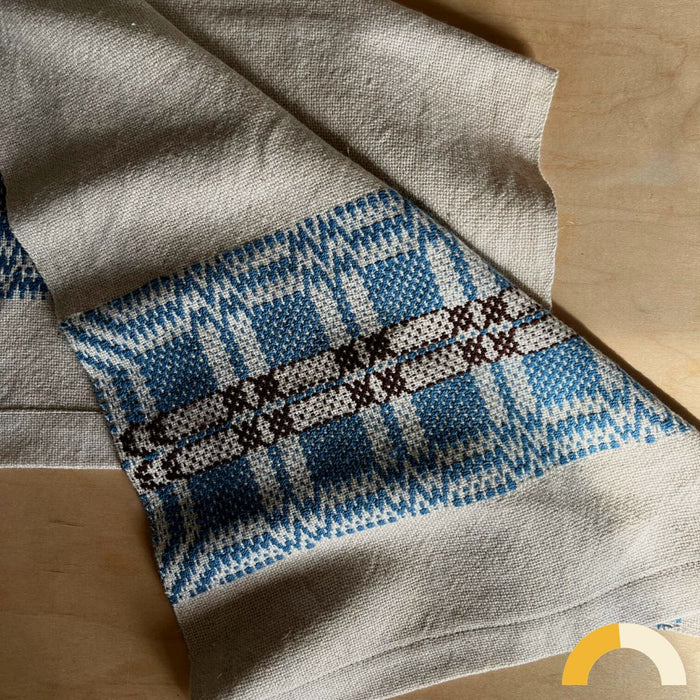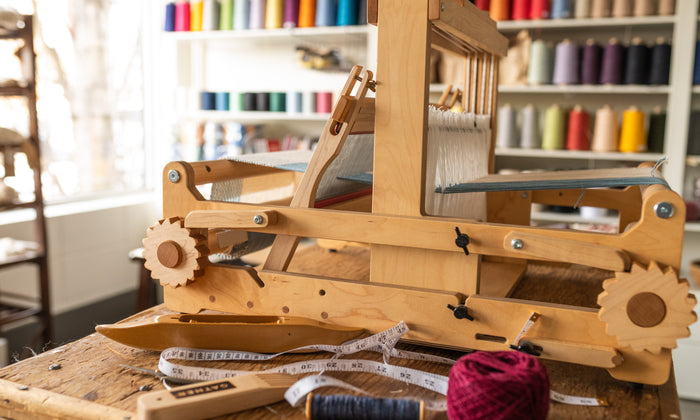Looms are beautiful tools that can be used for decades if well maintained.
Old looms are often relatively cheap and great to use. We’re going to talk over how to find, fix, and maintain old looms.
Buying a Used Loom
We love used looms--everyone who works here owns at least one. In Alberta, there are looms hidden in basements and garages all over the place. Often looms come up for sale as their owners downsize to move to retirement homes, or as part of estate sales. Other times, people simply don’t weave enough to justify keeping them! Many used looms around here are from the 1960s - 1980s, but we’ve used looms from the 1920s and earlier.
To find a used loom for sale:
- Ask weavers where you live where the loom listings happen
- Start regularly searching for looms to get a sense of what’s out there
- Keep an eye on usual sale prices for a few months Remember, there will ALWAYS be another loom! We see postings most often on Kijiji and Facebook Marketplace. You can also put the word out that you’re looking for a loom... sometimes one will find you.
Watch for how prices vary based on:
- Size
- # of shafts
- Brand. Here, Leclercs are cheap, Schachts are pricey
- Add ons and accessories
“Free” Looms
We have a saying around the studio: There’s no such thing as a free loom. Free is a great starting point, but we usually find that secondhand looms end up needing at least some money spent to get them in working order. This could be something as cheap and easy as a new brake coil and crank handle (both under $50) or something as pricey as major replacement parts or all new reeds ($150+).
Evaluating Looms
When I was a new weaver, I was offered two used 45" Leclerc Nilus looms: one from a friend for $375 and one from a friend’s mother for free. I took the free one and connected a weaving friend with the other, since it was a good deal. One of the looms turned out to be great, the other one turned out to be an absolute nightmare.
My loom was in excellent condition, came with a full set of extras, and I have been happily weaving on it for years. My friend’s loom was not a Nilus, not a Leclerc, not... any commercial loom. It was a deeply quirky homemade loom with very rough tension adjustment, had to be warped with two chains because the shafts were suspended on chains, was noisy and uncomfortable and just generally bad.
Photos: What to look for
Oftentimes you have to make at least initial decisions about whether or not to go for a loom based on photos. Can you see the full loom? Can you see the major components of the loom?
- Shafts
- Treadles
- Warp and Cloth Beams
- Breast and Back Beams
- Reed(s)
Can you see the smaller components of the loom?
- Canvas aprons
- Crank Handle
- Heddles
Can you see evidence of the loom’s stated manufacturer?
- Brand stickers
- Serial numbers
- Characteristic design elements Is the photo current and of the actual loom?
- Bonus: are there images showing the loom warped?
Questions to Ask
- Ask for images of anything that is a dealbreaker that you need to see
- Have you woven on this loom? Or, if selling on behalf of someone else, have they woven on this loom?
- Where has the loom been stored? If in a garage, basement, or attic, you may want to check for water or mouse damage.
- How old is the loom? “I don’t know” is not a great answer. You can make informed guesses based on loom style Looms that are 70+ years old may not have parts available if replacements are needed
- What brand is it? Do you recognize the brand? Is it still in operation? Do they still make parts? Is there a dealer in your town? How far would parts have to travel to reach you? For example we can get Schacht parts from Colorado in a few weeks, but Louet parts from Holland can take months to arrive.
- What comes with the loom? Bench? Reeds? Warping tools? Bobbin winders? This can make a big difference in whether the price is reasonable!
- Does the loom collapse or break down for transportation? This can also give hints about whether the style of loom is being listed accurately. Renting a van is a cost to factor in.
Evaluating Looms
With the difficult loom my friend ended up with, red flags were: the person selling it had not woven on it; it had been stored in an outdoor storage unit; there were no images of brand stickers or serial number tag.
Deal Breakers
Dealbreakers are going to be personal, but may include:
- Commercially made vs. homemade If you can’t make or creatively source parts, you may not want a homemade loom
- No weaving done on loom by current owner If you want to be particularly cautious, this is a good way to ensure that your loom is at a minimum functional
- Water or mouse damage, mould
- Major missing components or missing photos
Identifying Brands
Ideally, this is very easy. Most commercial looms have a brand logo stamped, burned, or stuck on them. However, if the brand identification is on a sticker, it can get lost. Even the parts that have a permanent brand of stamp can be replaced.
IIf you’re looking for brand markings, look for them on permanent, major parts of the loom. Just because something has a Leclerc crank handle or Schacht shafts doesn’t necessarily mean that company made the rest of the loom!
You can also look for characteristic features of specific brands. For example: Schacht crank handles are secured with a hex bolt Leclerc crank handles are easily removable Woolhouse ratchet and pawls are wooden, while most others are metal.
A lot of the basic framing pieces are the same or similar from brand to brand. Look at the little details to tell brands apart: Brake mechanisms Shaft separators Ratchet and pawl Take-up handle Crank handle
Look online for current and historical looms from brands you think are likely. Brand websites are obviously a good starting place, but dealers are also helpful and often have better images. Ask friends who weave, or local guilds, if they can help. Look for brand-specific accounts and groups on social media.
Identifying Models
Once you’ve sorted out your brand, you will likely need to narrow down your model. Different models use different parts, so it’s hard to repair or restore without this information.
Websites, dealers, and other weavers are still your best bet for information. A lot of loom manufacturers have long histories going back several decades. Over time, models of looms come and go. A source with historical information can be invaluable.
We got a used Leclerc loom at Gather at one point. It had been broken down for storage and transport, and we just had to put it back together. It was from a weaver who had woven on it recently, the Leclerc markings were there, everything should have been fine. BUT.
When I started putting it together, I couldn’t find all the pieces I was expecting. The serial number sticker confirmed that it was indeed a Leclerc Artisat, a model of loom I am super familiar with. So why couldn't I understand how to put it together?
After getting some help from a Leclerc-specific Facebook group, I figured out that the Artisat had initially been made with a built-in bench. The model with the bench was made for ONE YEAR, in 1969. Luckily, Camilla Valley Farms had the old manual in their online collection of Leclerc loom manuals, and I was able to build the loom.
Characteristics that might help identify a model:
- Frame style: standard vs. X-frame
- How collapsible the loom is
- Available widths
- Shedding mechanism: jack, counterbalance, countermarche
- Position of brake release
- Style of treadles or levers
- Castle
Identifying Age
Identifying the age of your loom will also help you make repairs to it. Some older looms have specific differences in construction and parts based on age, even among the same model. For example, I now have two 45" Leclerc Nilus looms, one from the 1960s and one from the 1970s. The shafts on the older loom are separated by metal bars, while the newer loom has (extremely fragile) plastic pegs doing the same job.
These differences can be significant! Leclerc counterbalance looms from before the 1980s do not have shed regulators, which restricts your structure options when weaving on them. Newer Leclerc counterbalance looms come with this standard. Adding one is a $500 upgrade!
Leclerc serial numbers include the year of manufacture. Style of logo on the brand sticker or other marking can also tell you the age. Again, manufacturers, dealers, and online groups may know specific quirks.
Fixes and Repairs
When you get a new old loom, go over it and check for missing parts and damage. Having the manual for your loom can be a big help. An experienced weaving friend can be just as good!
Common missing parts:
- Crank
- Handles
- Washers and wingnuts
- Aprons and apron rods
- Shaft separators
Look for damage in any wooden parts. Rough spots where warp or cloth will come in contact should be sanded and sealed with linseed oil or equivalent. Mould may require a replacement part. Nicks, scratches, and other surface damage is part of the deal!
Check for damage in cloth and rope parts: Canvas aprons are the big one. Water/mould/mice damage usually means replacing an apron. They are easy to remove: pull out the staples or nails that attach them to the beam. Install a new apron with flat-headed nails, or swap your cloth apron for texsolv cords.
Check for damage in cloth and rope parts: We often overlook the rope connections on our looms. Check the rope connecting the brake release lever for fraying, water damage, etc Replace with heavy texsolv if necessary. Check the cords connecting treadles to lamms under shafts If replacing, be very sure of the length of original pieces as this can be model-specific.
Check for damage in metal parts: Look for rust on heddles and reed. Clean with CLR or replace. Check for any bent sections in reeds. Bent reeds are unusable. Check metal friction brake coil. Replace if the coil has kinks or rust that make it difficult to release. Check screws, bolts, hinges, nails including treadle attachment. Tighten as needed Replace as needed
Check for damage in shafts: Are all shafts installed facing the same way? Are the bars that hold the heddles in good condition? Do they anchor firmly into the sides of the shafts? Are there clips or hooks in the middle of the shafts securing the bars? Are they in good condition? If the shafts have wooden frames, is there any water/mouse/mould damage?
Check for damage in shafts: How are the shafts separated from each other? Is the separation mechanism working? Do the shafts move easily independently, or is there anywhere they catch on each other? Look where the shafts sit on the lamms (wooden levers that lift shafts on jack looms). Do they sit cleanly and evenly? Clean out any dirt/fluff/lost sley hooks that have fallen in there.
Priorities
The most important parts to fix or replace are any damaged parts that come into direct contact with your warp or your cloth:
- Aprons
- Back beam
- Heddles
- Reed
- Breast Beam
Trial Run
Try a simple, low stakes warp to ensure your loom is working. If your reed shreds warp, better not to discover than on ten yards of silk! Use materials you are comfortable with and a familiar weave structure so that you know any issues are being caused by the loom, not by your yarn or design.
Troubleshooting
If you run into problems, look for information related to the specific loom and the specific problem. Small shed? Helps to know whether or not the loom you’re using generally has a small shed. Looking for images or videos of the loom in use can be very helpful for figuring out whether something is a design flaw in your loom or a maintenance issue that needs addressing.
Don’t be afraid to grab a screwdriver and see how adjusting your loom can change your weaving experience! Brake release levers can be really finicky... changing the length of cord can solve a lot of ‘sticky brake’ issues. Some looms have adjustable reed height, adjustable reed position, etc.
Sourcing Parts
Many manufacturers sell individual replacement parts. Dealers can source them for you. We source parts from Leclerc, Schacht, Woolhouse (Fiber Supply), Harrisville, and Louet here at Gather. You may find parts at guild sales. If you are handy or know someone who is, they can sometimes make you a piece you need. Here’s another place where manuals can be handy.
Maintaining your loom
Once your loom is in ship shape, keep it that way by: Minimizing direct sun exposure Controlling humidity Periodically tightening screws Oiling moving metal parts Re-finishing as needed.
Upgrades
Texsolv is your friend! It’s strong, crocheted nylon cord used by many modern loom manufacturers (like Schacht and Woolhouse) for heddles as well as various connections and mechanisms.
Texsolv can replace: Metal heddles Canvas aprons Brake release lever cords Tie up cords It’s cheap and durable.
Major Alterations
Sectional Warp Beams: upgrade kits consist of four sectional “rakes” that are screwed onto the back beam to allow for sectional beaming Shed Regulator: allows older counterbalance looms to weave unbalanced structures
Back-hinge treadles: available on some 8-shaft looms to reduce force needed to treadle
Additional shafts: if your loom has some extra space on the side walls behind its shafts, it may be a “four now, four later” loom that can optionally be converted into an 8-shaft loom. Other Conversions: some looms have kits available to alter their shedding mechanism.
Major alterations are often expensive and take some labour to install. I suggest getting to know your loom first, and making these changes if you are very confident that you want a specific alteration. That said I absolutely have immediately altered old looms because I have very little self-control.








